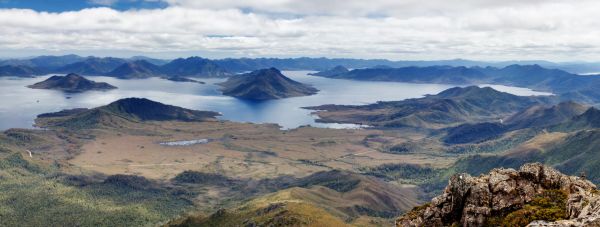Tasmania is burning
As I write this, fire is 500 metres from the largest King Billy pine forest in the world on Mt Bobs, an ancient forest that dates back to the last Ice Age and has trees over 1,000 years old. Fire has broached the boundaries of Mt Field national park with its glorious alpine vegetation, unlike anything on the planet. Fire laps at the edges of Federation Peak, Australia’s grandest mountain, and around the base of Mt Anne with its exquisite rainforest and alpine gardens. Fire laps at the border of the Walls of Jerusalem national park with its labyrinthine landscapes of tarns and iconic stands of ancient pencil pine and its beautiful alpine landscape, ecosystems described by their most eminent scholar, the ecologist Prof Jamie Kirkpatrick, as “like the vision of a Japanese garden made more complex, and developed in paradise, in amongst this gothic scenery”.
“You have plants that look like rocks – green rocks – and these plants have different colours in complicated mosaics: red-green, blue-green, yellow-green, all together. It’s an overwhelming sensual experience really.”
Five years ago I was contacted by a stranger, Prof Peter Davies, an eminent water scientist. He wanted to meet because he had news he thought would interest me. The night we met Davies told me that the south-west of Tasmania – the island’s vast, uninhabited and globally unique wildland, the heart of its world heritage area – was dying. The iconic habitats of rainforest, button grass plains, and heathlands had begun to vanish because of climate change.
I was shocked. I had understood that climate change’s effects on Tasmania would be significant but not disastrous; the changes mitigated by Tasmania being surrounded by seas that were not heating as quickly as others: the island’s west would get wetter, the east a little warmer and drier, but compared to much of the world it didn’t seem catastrophic.
But it wasn’t so. Tasmania’s sea waters were warming at two to three times the global rate. Davies’ work, with that of other scientists, was revealing the warming and drying of Tasmania’s west and highlands, and the growing impact this was having. The highland lakes of Tasmania would, for example, in the next 70 to 100 years see between a 10% and 20% drop in rainfall, coupled to a 20% to 30% increase in evaporation. By the end of this century a significant proportion of these lakes and wetlands will cease to exist or be largely dried out much of the year.
Then there was the startlingly new phenomenon of widespread dry lightning storms. Almost unknown in Tasmania until this century they had increased exponentially since 2000, leading to a greatly increased rate of fire in a rapidly drying south-west. Compounding all this, winds were also growing in duration, further drying the environment and fuelling the fires’ spread and ferocity.
Such a future would see these fires destroy Tasmania’s globally unique rainforests and mesmerising alpine heathlands. Unlike mainland eucalyptus forest these ecosystems do not regenerate after fire: they would vanish forever. Tasmania’s world heritage area was our Great Barrier Reef, and, like the Great Barrier Reef, it seemed doomed by climate change. [Continue reading…]
